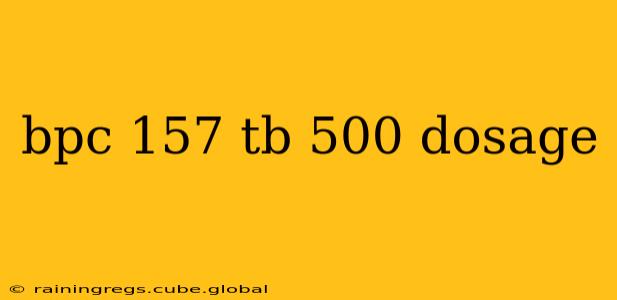BPC 157 and TB-500 are two peptides gaining popularity for their potential therapeutic benefits, particularly in promoting tissue repair and healing. However, it's crucial to understand that these are research chemicals and not FDA-approved medications. This information is for educational purposes only and should not be considered medical advice. Always consult with a qualified healthcare professional before using BPC 157 or TB-500.
Understanding BPC 157 and TB-500
Before diving into dosage, let's briefly review each peptide:
BPC 157 (Body Protective Compound 157): This pentadecapeptide is a naturally occurring compound found in the human stomach. Research suggests it may promote healing in various tissues, including tendons, ligaments, muscles, and the gastrointestinal tract. Its mechanism of action is complex and still being investigated, but it's believed to influence cell signaling pathways involved in tissue repair.
TB-500 (Thymosin Beta-4): This naturally occurring peptide is found in most human cells and plays a critical role in cell growth, wound healing, and inflammation. Research indicates that it may accelerate the healing process of various injuries and reduce inflammation. Similar to BPC 157, the exact mechanisms are still being explored, but it's known to influence actin polymerization and angiogenesis (the formation of new blood vessels).
Dosage Recommendations for BPC 157
Dosage recommendations for BPC 157 vary widely depending on the individual, the specific condition being treated, and the route of administration. There's no universally accepted standard dosage. Research studies have used various dosages, and the optimal dosage remains a topic of ongoing investigation. Commonly reported ranges include:
- 250 mcg to 500 mcg per day: This is a frequently cited starting point, often administered once or twice daily.
- 1000 mcg per day: Some users may increase the dosage to 1000 mcg per day, often divided into two injections.
Important Considerations for BPC 157 Dosage:
- Route of Administration: BPC 157 is typically administered subcutaneously (under the skin) or intramuscularly (into the muscle).
- Individual Response: Individuals may respond differently to the same dosage.
- Cycle Length: Cycles typically last several weeks.
Dosage Recommendations for TB-500
Similar to BPC 157, TB-500 dosage also lacks a universally accepted standard. Research studies have used a range of dosages, and individual responses vary. Reported dosages include:
- 2 mg to 5 mg per week: This is a common dosage range, often administered once or twice a week. Some users divide the weekly dose into two or three injections.
- 200 mcg to 500 mcg per day: Some users opt for daily injections in lower dosages.
Important Considerations for TB-500 Dosage:
- Route of Administration: TB-500 is typically administered subcutaneously.
- Individual Response: As with BPC 157, individual responses to TB-500 vary greatly.
- Cycle Length: Cycles typically last for several weeks.
What are the potential side effects of BPC 157 and TB-500?
While generally considered well-tolerated, both BPC 157 and TB-500 may cause some side effects. These can include mild injection site reactions such as redness, swelling, or itching. More serious side effects are rare but possible. Always monitor your body for any adverse effects.
How long does it take to see results from BPC 157 and TB-500?
The timeframe for observing noticeable results can vary significantly depending on the individual, the specific condition being treated, and the dosage. Some users report noticing improvements within a few days or weeks, while others may require longer periods. Patience and consistency are key.
Are there any interactions with other medications?
It's crucial to inform your healthcare professional about all medications and supplements you're taking before considering BPC 157 or TB-500. Potential interactions with other medications exist, and your doctor can assess the risks and benefits.
Where can I buy BPC 157 and TB-500?
These peptides are research chemicals, and their legal status varies depending on your location. You should consult the regulations in your area before purchasing or possessing these substances. Due to the lack of regulation, quality and purity can vary significantly between suppliers. It is essential to source from reputable suppliers to minimize potential risks.
Disclaimer: This information is for educational purposes only and does not constitute medical advice. Always consult with a qualified healthcare professional before using BPC 157 or TB-500. The information provided here is based on research and anecdotal evidence, and individual results may vary. The use of BPC 157 and TB-500 carries inherent risks, and it's crucial to proceed with caution.
